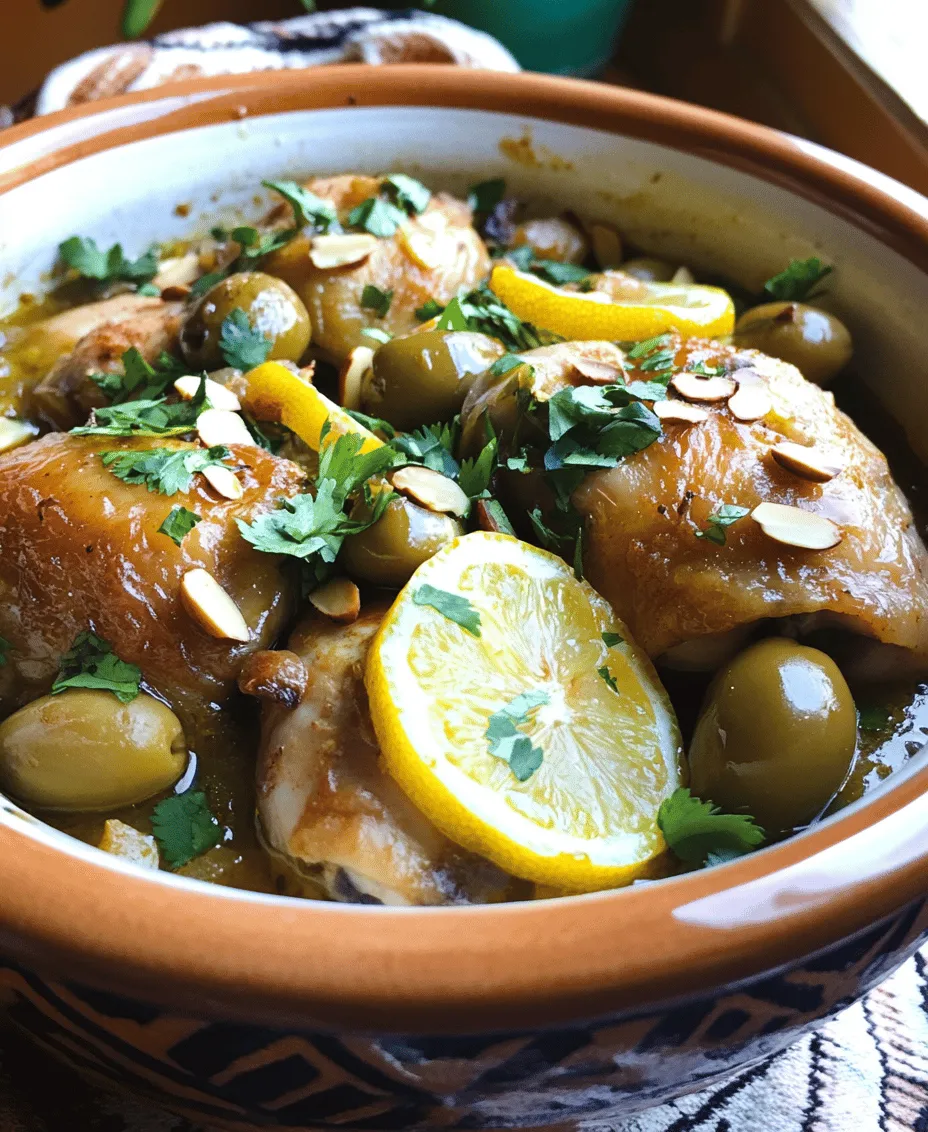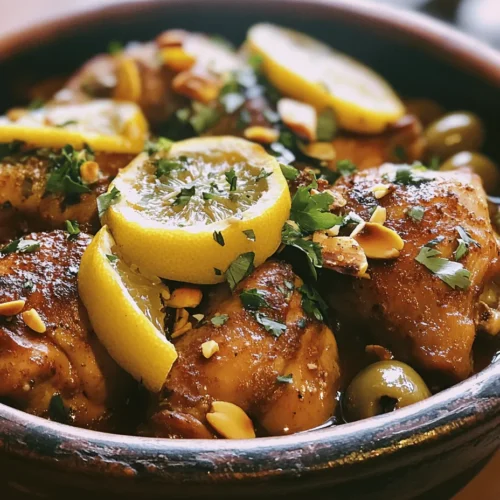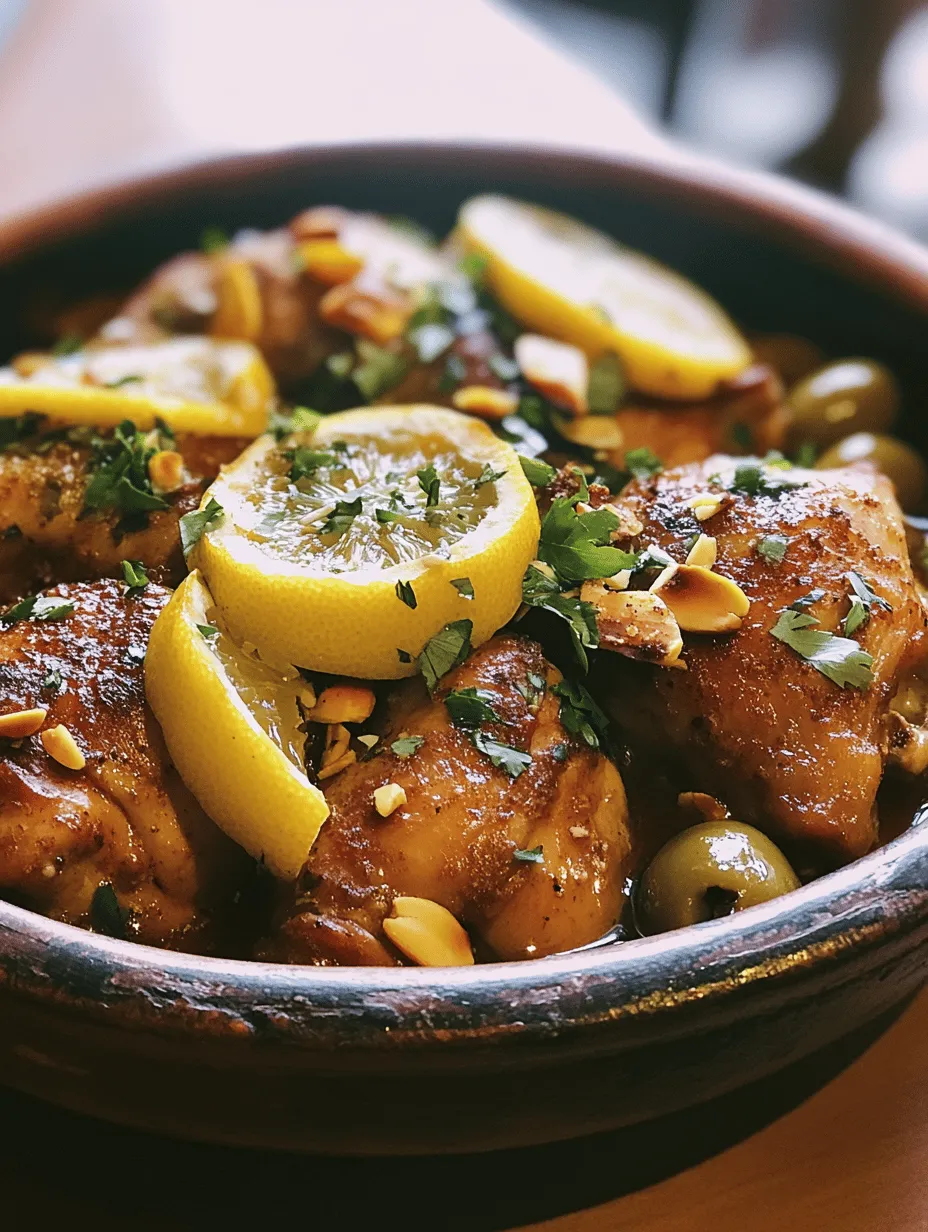Delve into the vibrant flavors of Moroccan cuisine with this Zesty Chicken Tagine with Olives and Lemons. This dish not only showcases the aromatic spices and wholesome ingredients that define Moroccan cooking but also offers a delightful balance of savory, tangy, and nutty flavors. Perfect for family dinners or special occasions, this tagine is sure to impress with its rich taste and fragrant aroma. Join us as we explore the origins, ingredients, and detailed preparation of this mouthwatering recipe.
Understanding Tagine: A Culinary Tradition
Exploring the Origins of Tagine
The tagine is more than just a dish; it’s a symbol of Moroccan culture and a testament to its rich culinary heritage. Historically, the tagine pot—characterized by its conical lid—has been used for centuries in North African cooking. This distinctive cookware allows for slow-cooking and steaming, which helps to infuse the dish with flavors while retaining moisture. The origins of tagine can be traced back to the Berber tribes, who utilized earthenware pots over open fires, making it a staple for communal dining.
In Moroccan culture, tagine is often served as a centerpiece at meals, emphasizing the importance of sharing and hospitality. It is common to see families and friends gather around a large tagine, scooping up the flavorful contents with pieces of bread. This communal style of dining not only enhances the experience of eating but also embodies the warmth of Moroccan hospitality.
The Unique Flavors of Moroccan Cuisine
What truly sets Moroccan cuisine apart is its complex layering of flavors, achieved through a careful balance of spices. Key spices such as cinnamon, cumin, and coriander create a tapestry of taste that can move from sweet to savory with each bite. Moroccan dishes often incorporate a variety of flavors, including sweet fruits, savory meats, and fragrant spices, resulting in a unique culinary experience.
The balance of flavors is essential in Moroccan cooking; the interplay between sweet, savory, and spicy elements creates a harmonious dish. Regional variations also play a significant role, with coastal areas favoring seafood while inland regions lean toward hearty meats and vegetables. Each tagine recipe is a reflection of local ingredients and traditions, making every dish unique.
Ingredients Breakdown
Essential Ingredients for Zesty Chicken Tagine
The foundation of our Zesty Chicken Tagine lies in its carefully selected ingredients. At the heart of this recipe are chicken thighs, which are preferred for their rich flavor and tender texture. Unlike chicken breasts, thighs retain moisture during cooking, which is crucial for achieving the succulent results associated with tagine dishes.
Olive oil is another essential ingredient in this recipe, adding depth and richness. In Moroccan cuisine, olive oil is not just a cooking fat; it is a flavor enhancer that contributes to the overall authenticity of the dish. The use of high-quality extra virgin olive oil will elevate the taste of the tagine, making each bite more enjoyable.
Aromatics like onions and garlic play a vital role in building the base flavor of the dish. Onions add sweetness and depth, while garlic provides a pungent kick that balances the dish’s overall profile. Together, these ingredients create a fragrant foundation that sets the stage for the spices to shine.
The Spice Palette
The spices used in this Zesty Chicken Tagine are what truly elevate it to a new level of flavor. Each spice brings its unique character to the dish:
– Ginger: This spice adds a warm, slightly peppery flavor that complements the other ingredients beautifully. Fresh ginger is preferred for its bright, zesty notes.
– Cumin: Known for its earthy and nutty flavor, cumin is a staple in Moroccan cooking. It adds warmth and depth, creating a robust flavor base.
– Cinnamon: Often associated with sweet dishes, cinnamon in savory cooking contributes a warm, sweet-spicy note that enhances the overall flavor profile of the tagine.
– Turmeric: This spice not only brings a vibrant yellow hue to the dish but also imparts an earthy flavor. Turmeric is well-known for its health benefits, making it a nutritious addition.
– Paprika: Sweet paprika adds color and a subtle smokiness, enriching the dish’s flavor without overpowering it.
When selecting spices, opt for high-quality, fresh options. Whole spices can be ground just before use to ensure maximum flavor, making a significant difference in your dish’s outcome.
Fresh Ingredients That Make a Difference
Fresh ingredients are crucial to the success of this recipe. Fresh cilantro adds a burst of bright flavor, enhancing the dish’s freshness and providing a beautiful garnish. Its herbaceous notes contrast wonderfully with the savory elements of the tagine.
Olives are another key component, with Kalamata and Castelvetrano varieties both offering distinct flavors and textures. Kalamata olives bring a rich, briny taste, while Castelvetrano olives are known for their sweet, buttery profile. The choice of olives can significantly impact the dish, allowing you to tailor it to your taste preferences.
Lastly, lemon slices are essential for introducing acidity and brightness to the tagine. The citrusy notes from the lemons cut through the richness of the chicken and olives, creating a well-rounded dish that tantalizes the palate.
Step-by-Step Cooking Instructions
Preparing the Chicken: A Crucial First Step
Before diving into the cooking process, proper preparation of the chicken is essential for achieving the best results. Start by patting the chicken thighs dry with paper towels. This step is crucial for optimal searing, as excess moisture can prevent the chicken from developing a beautiful golden-brown crust when cooked.
Next, season the chicken generously with salt and pepper. This not only enhances the flavor of the meat but also helps to create a delicious crust during the searing process. The seasoning should be applied evenly, ensuring that every bite of chicken is flavorful.
With your chicken prepped and seasoned, you are now ready to bring this vibrant dish to life. As you continue with the cooking instructions, you will see how each step builds upon the last, creating layers of flavor that make this Zesty Chicken Tagine a standout recipe in any culinary repertoire.

Searing the Chicken: Building Flavor
To start your Zesty Chicken Tagine with Olives and Lemons, the first step is to sear the chicken. This technique is crucial for developing a rich, complex flavor profile in your dish. Achieving a perfect golden-brown crust on your chicken thighs involves a couple of essential techniques.
Techniques for Achieving a Perfect Golden-Brown Crust
1. Pat Dry: Before searing, ensure your chicken is dry. Use paper towels to pat the thighs thoroughly. Moisture on the surface will steam the chicken rather than sear it, preventing that desirable crust from forming.
2. High Heat: Preheat your tagine or skillet over medium-high heat. Add a splash of olive oil once it’s hot. You want the oil shimmering but not smoking. A hot pan is essential to initiate the Maillard reaction, which gives the chicken its rich color.
3. Don’t Overcrowd the Pan: If you’re cooking multiple pieces of chicken, do it in batches. Overcrowding lowers the pan’s temperature, leading to steaming instead of searing. Give each piece space to develop that golden crust.
4. Leave It Alone: After placing the chicken in the pan, resist the urge to move it around. Allow it to sear undisturbed for about 5-7 minutes until the underside is golden brown. Flip and repeat on the other side.
Understanding the Science Behind the Maillard Reaction in Cooking
The Maillard reaction is a complex chemical reaction between amino acids and reducing sugars that occurs when food is heated. This reaction not only creates the desirable brown color but also develops deep, savory flavors. Searing is therefore not just a cooking technique; it’s a foundational step in layering flavors in your tagine.
Cooking the Aromatics: The Foundation of Flavor
Once the chicken is seared to perfection, it’s time to build on that flavor foundation with aromatics. Onions and garlic are pivotal in Moroccan cooking, adding sweetness and depth to the dish.
How to Properly Sauté Onions and Garlic for Maximum Flavor
1. Slicing the Onions: Start by thinly slicing the onions. Uniform slices ensure even cooking. Add the onions to the same pan after removing the chicken. The residual oil and fond (brown bits) left in the pan will flavor the onions beautifully.
2. Cooking Time: Sauté the onions over medium heat until they become translucent and begin to caramelize, around 5-7 minutes. This slow cooking helps to sweeten the onions, enhancing the overall flavor of the dish.
3. Adding Garlic: Once the onions are nearly done, add minced garlic and sauté for an additional 1-2 minutes. Garlic cooks quickly and can burn, so keep an eye on it. The fragrant aroma will elevate your dish significantly.
The Significance of Toasting Spices Before Adding Liquids
Toasting spices is a simple yet effective way to maximize their flavor. In this recipe, you’ll be using spices such as cumin, coriander, and cinnamon. Here’s how to do it:
1. Add Spices: Once the onions and garlic are sautéed, lower the heat slightly and add the spices to the pan. Stir them in for about 30 seconds. This process releases the essential oils in the spices, enhancing their flavor and aroma.
2. Watch for Fragrance: You’ll know the spices are toasted when they become fragrant. Be careful not to let them burn, as this can lead to bitterness.
Creating the Flavorful Base
With your aromatics ready, it’s time to create the flavorful base that will make your tagine irresistible.
Detailed Guidance on Combining Broth and Tomatoes for Richness
1. Add Chicken Broth: Pour in the chicken broth gradually, scraping the bottom of the pan to release any flavorful bits stuck to it. This deglazing process incorporates all the flavors developed during searing and sautéing.
2. Tomatoes: Next, add diced tomatoes (fresh or canned). This addition not only adds acidity but also contributes to the overall richness of the sauce. Stir to combine everything, ensuring the broth and tomatoes are well mixed.
3. Simmering Ingredients: Bring the mixture to a gentle simmer. This step is crucial as it allows the flavors to meld together beautifully.
The Importance of Layering Flavors in Cooking
Layering flavors is the essence of creating a complex dish. By adding ingredients in stages—first the chicken, then the aromatics, followed by the liquids and spices—you develop a multi-dimensional flavor profile. Each ingredient builds on the last, resulting in a harmonious and delicious final dish.
Simmering to Perfection: The Slow-Cooking Process
Simmering is where the magic happens. It allows the chicken to cook through while absorbing the flavors of the broth and spices.
Techniques for Maintaining the Right Temperature During Simmering
1. Adjust the Heat: Keep your pot at a gentle simmer rather than a rolling boil. Too high a temperature can toughen the chicken. Adjust the heat as necessary to maintain a steady simmer.
2. Lid On or Off: Cover the tagine with its lid or use a tight-fitting lid if using a skillet. This helps retain moisture and ensures even cooking.
How to Know When the Chicken is Fully Cooked and Tender
Chicken thighs typically require about 45 minutes to 1 hour of simmering to become tender. Use a meat thermometer to check for doneness; the internal temperature should reach at least 165°F (75°C). Alternatively, test the chicken with a fork—if it pulls apart easily, it’s ready.
Finishing Touches: Adding Freshness and Garnish
Once your chicken is tender, it’s time to add the finishing touches that elevate your tagine.
Techniques for Incorporating Cilantro at the End for Optimal Flavor
1. Chop Fresh Cilantro: Just before serving, chop fresh cilantro and sprinkle it over the dish. Adding herbs at the end preserves their vibrant flavor and color, providing a fresh contrast to the rich sauce.
The Optional Use of Toasted Almonds or Pine Nuts for Texture Contrast
For an added layer of texture, consider toasting slivers of almonds or pine nuts. Toast them lightly in a dry pan until golden, then sprinkle them on top of your tagine before serving. This garnish not only adds crunch but also enhances the visual appeal of the dish.
Serving Suggestions
Best Accompaniments for Chicken Tagine
To truly enjoy your Zesty Chicken Tagine, pair it with traditional Moroccan side dishes that complement its flavors.
– Couscous: This fluffy grain is a classic accompaniment. It soaks up the delicious sauce from the tagine beautifully, making for a satisfying meal. Prepare couscous according to package instructions, adding a touch of olive oil and herbs for flavor.
– Rice: For a different base, serve the tagine over a bed of steamed rice. This provides a neutral backdrop that allows the vibrant flavors of the tagine to shine.
– Crusty Bread: A loaf of crusty bread is perfect for scooping up the tagine. Serve fresh, warm bread on the side for a rustic experience.
Creating a Complete Meal Experience
To create a complete meal experience, consider adding a simple salad with fresh vegetables and a light vinaigrette. This adds a refreshing crunch that balances the warmth of the tagine.
Presentation Ideas for Serving Tagine
Tips for Garnishing and Presenting the Dish Attractively
1. Use a Traditional Tagine: Serving your dish in a traditional tagine pot adds authenticity and warmth. The colorful ceramic of the tagine enhances the visual appeal of your meal.
2. Garnish Generously: When plating, garnish with the chopped cilantro and any toasted nuts. The vibrant green and golden hues create an inviting presentation.
3. Add Lemon Wedges: Serve with lemon wedges on the side for an extra zesty kick. Guests can squeeze fresh lemon juice over their servings to enhance the flavors.
The Importance of Serving in a Traditional Tagine Versus Modern Dishware
While modern dishware can be functional, serving in a traditional tagine creates an immersive dining experience. It invites guests to appreciate the cultural roots of the dish and enhances the overall meal atmosphere.
Nutritional Insights
Health Benefits of Ingredients Used
1. Nutritional Profile of Chicken Thighs: Chicken thighs are not only delicious but also packed with protein and iron. This makes them an excellent choice for a nutrient-dense meal.
2. Benefits of Olives and Lemons in a Balanced Diet: Olives are rich in healthy fats and antioxidants, while lemons provide a burst of vitamin C, enhancing the dish’s nutritional value. Together, they contribute to heart health and improved digestion.
3. The Role of Spices and Herbs in Providing Antioxidants: The array of spices used in this recipe, including cumin and coriander, are known for their antioxidant properties. They not only enhance flavor but also promote overall health.
Conclusion
Zesty Chicken Tagine with Olives and Lemons is much more than just a meal; it encapsulates the warmth and vibrancy of Moroccan culture. With its aromatic spices, tender chicken, and bright citrus notes, this dish promises to be a favorite in any household. Whether you’re familiar with Moroccan cuisine or new to these flavors, preparing this tagine will not only delight your palate but also enrich your culinary skills. Enjoy the journey of creating and savoring this beautiful dish, and let it transport you to the bustling markets and warm kitchens of Morocco.



